
Features
Business
Trends
Growing in the Green: Are your combos profitable? Two
December 19, 2012 By Melhem Sawaya
Last issue I shared with you a detailed outline of the different factors that need to be considered in planning combinations.
Last issue I shared with you a detailed outline of the different factors that need to be considered in planning combinations. In this article I am going to expand on the outline in discussing the following topics:
- Perceived understanding of mixed containers.
- Mixed container definition.
- Types of mixed containers.
- Production.
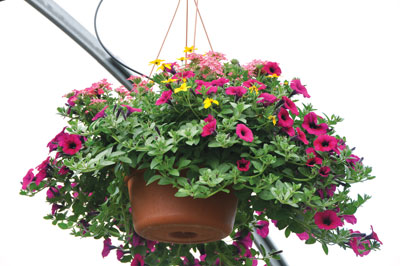 |
|
| A well-coordinated combination that needs lots of light and must be finished cool. PHOTOS COURTESY MELHEM SAWAYA
|
PERCEIVED UNDERSTANDING OF MIXED CONTAINERS
■ Leftover liners. The days of thinking that you can put together plants that are left over from other plantings are over; combinations are planned crops and not a last minute thought.
Sticking in a couple of trailers the week of shipping. Following along with that same scenario, if you received orders for combinations and are short on availability, for a fast fix you could put in a couple of trailing plants. However, you will end up with a patched up inferior product that will probably result in you losing this order for the next season.
Magazine pictures. Utilizing pictures from a magazine and making these designs the basis for most of your production is rarely a good idea.
Your containers will rarely look as good as the photos.
What’s the problem? Perhaps the plants do not survive together for a long time, or the combination looks great for one week and then falls apart. Or you could find that cultivars may clash and the more vigorous ones take over, resulting in what was once a four-to-six-variety combination ending up being a two-to-four combination – sometimes it turns out to be a single-variety combination!
DO ANY TRIALLING ON A SMALL SCALE
■ Try to copy the photo on a small scale and see how it works for you and the consumer, and then expand on the program if it performs well and is profitable.
Starting with a favourite cultivar and then adding anything that goes with it. Many combinations have to have a certain cultivar because it is a favourite, and the feeling sometimes is that any other cultivar will work with it. Customers, however, have different tastes and we should avoid forcing our “favourites” on them; we might end up only expanding the recycling pile!
A cultivar surplus ends up being lumped in with other cultivars. Computers are great tools, but adding an extra zero to an order can happen easily and often. The extras often end up in every combination.
Correcting mistakes early in the crop cycle is the most cost-effective stage. The ultimate goal in dealing with the surplus is to increase sales rather than to hinder them, especially at a time when growing area is very critical.
What should you do? For starters, use them in combinations only if they enhance them. You can also try to sell the surplus or some of them.
You might be able to spread the surplus over different pot sizes you are already growing. However, if none of these or any other solutions meet the market demand, it is much more cost-effective to discard the extras at the propagation stage.
WHAT IS YOUR DEFINITION OF A MIXED CONTAINER?
■ Growers should have their own definition of a mixed container (combination). It is like a mission statement for your operation. It sets the basic standards and principles for your combination program.
This is my definition: a mixed container is a group of three to four cultivars that would look better and generate higher marginal profit in a combination than separate.
THERE ARE MANY TYPES OF MIXED CONTAINERS
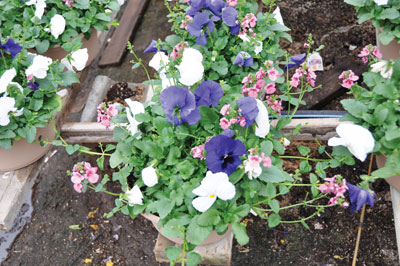 |
|
| A combination ideal for cool growing areas and early sales. |
|
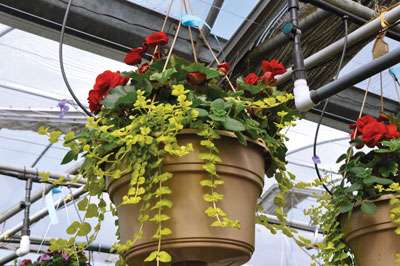 |
|
| A combo that’s excellent in the shade. | |
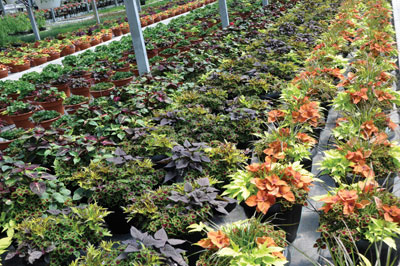 |
|
| Combinations of mainly textured leaves and excellent colour coordination. | |
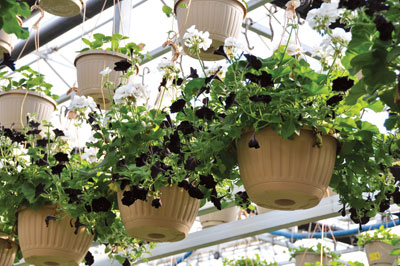 |
|
| A combination of unmatched cultivars grown in less than optimum light. | |
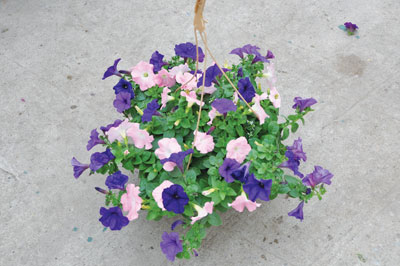 |
|
| This combo is simple in design, with good matching habits and an excellent marginal profit. | |
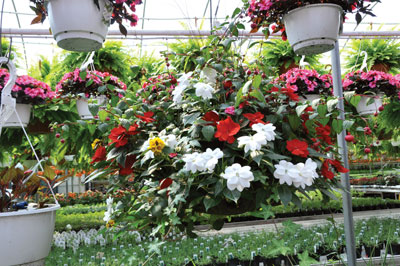 |
|
| An impressive combination that will do well even in shaded areas.
|
■ Some have three or four cultivars of the same genus, i.e., three petunias or three calibrachoa of different colours that have the same growing habit.
Some have three to four genera per container, i.e., petunia, calibrachoa and verbena, or lobelia, pansy and bacopa. Remember to select genera that grow well under similar cultural conditions.
Colour-coordinated varieties are becoming very popular, because they are intended to match certain window shutters, doors and or patio furniture.
Make sure the combination meets the standard you set for yourself for combinations.
Some designs coordinate leaf size and texture so that one variety doesn’t take over the whole container.
Soil. With any other crop, combo or otherwise, the potting media should be tested by an independent media testing laboratory. This will confirm that the pH level is where you want it to be.
My preference is to have a pH between 5.5 and 5.8 since 90 per cent of the main combo cultivars are petunia and calibrachoa. This pH is not the best for geraniums, but that’s OK because geraniums do not belong in any combination – by July they’ll be dwarfed by the rest of the plants.
Soil EC should be between 0.6 and 0.7 using the “Two Water To One” media test by volume.
Water. Water liners or 4” containers with a fertilizer of 1.5 to 2.0 EC before planting.
Water the media before planting to avoid overwatering after and to prevent plants from getting buried. Water lightly after planting until the plants are well established.
Fertilizer. Use fertilizer to adjust your pH. To make media:
- More acidic, use 18-9-18.
- More alkaline, use 14-0-14.
- More neutral, use 17-5-17.
Knowing your crops and what they prefer makes the difference between “OK” and “excellent” crops. Only by doing soil testing will you be able to catch fertility variances before they end up being a problem.
Light. Whether it is a combination or a straight variety in a pot, light is very important.
Provide sufficient room all around the container so all the plants are exposed to light, especially with plants that trail down the sides. You can start containers pot to pot, and then space them out to finish.
Temperature. Most crops should be started warm (18-20ºC) and then finished cool. Some can only go down to 5-6ºC, while others shouldn’t go below 13ºC.
CHOOSE COMPATIBLE CULTIVARS FOR COMBOS
■ It’s important to pick cultivars that are temperature compatible when planning your combinations. The worse scenario is to grow a cool-loving variety that trails warm, such as petunia. Some crops cannot take cool temperatures, such as ipomoea or annual and perennial hibiscus.
Pest control. In spring production, many cultivars are being grown, which makes pest control an interesting task. Many steps need to be taken:
- Start with clean plant material.
- Know the potential pests that could be an issue.
- If biologicals are used, treat preventively.
- If chemicals are used, monitor very closely and treat accordingly.
- Many times a crop has to be “cleaned up” chemically and then biologicals are introduced. In this case, knowledge of chemical controls is important so you can select products best suited for a program with the biologicals you are planning to use. Most of the time, both chemicals and biocontrols are needed in a way that they can complement each other.
- Apply pest treatments before flowering or at least three weeks before shipping. Generally speaking, flowers are more sensitive to chemicals than foliage.
Liners. All varieties planted should have been rooted in the same media. Check that the plants are active and alive, and not yellow. They should not be “doped” with PGRs. Don’t crowd them and finish the crop in full light.
In the next issue, we will finish this series by sharing costing combinations and more guidelines for profitable mixed containers.
Melhem Sawaya of Focus Greenhouse Management is a consultant and research coordinator to the horticultural industry. Comments on this or any other article are always welcome; please e-mail mel@focusgreenhousemanagement.com, or visit www.focusgreenhousemanagement.com.
Print this page